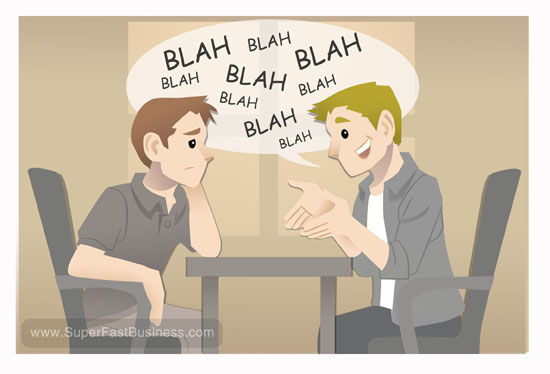Podcast: Download (Duration: 5:43 — 5.2MB)
Get Notified Of Future Episodes Apple Podcasts | Spotify | Amazon Music | Android | Blubrry | Gaana | TuneIn | Deezer | Anghami | RSS | More
Improve your business with these tips:
00:24 – When a client wants more and longer meetings
00:51 – Parkinson’s law: work expands to fill the time available
01:16 – Change the plan structure (and pricing)
01:41 – What happens when people delay payment?
01:56 – Start work after payment clears
02:50 – Four things for training staff
03:50 – Marketing segmentation
04:33 – What are you going to do when your business doubles?
Transcription:
James Schramko here with a business news update.
In this episode we’re going to talk about how to train your staff, how to get paid from customers who pay you badly, how to get rid of that annoying problem where customers overextend their meeting allocation, plus we’ll have a look at what happens when your business doubles and also we’ll cover marketing segmentation. Let’s get into it.
Be in control of your time during meetings.
When you have a client that just wants to have more meetings than they should be having and the meetings blow out and you just hear “wah wah wah wah.” Then what you want to do is schedule the meeting with that client before another meeting. And when the meeting starts, just let the client know and you can even gesture to your watch and just say, “I have another meeting in about 30 minutes from now, let’s go.” So now you’ve framed the meeting with a specific deadline.
With Parkinson’s Law we know that things fill to accommodate the time available. So when you have a specific time, things will speed up. Also if they want to meet more frequently than required, firstly you can signal that that’s different to what normally happens so they are a little bit of an exception, not the norm. Make sure you gently remind them that. And secondly, you can actually suggest that they move to a different plan. Just say the plan you’re on allows for 1 meeting per ‘X’, if you’d like to do more than that we can accommodate that it’s just going to be on a different plan and of course you should charge more. You need to charge a premium for clients who are going to suck up more of your time and energy because there’s a value on your time and energy. Make sure you get compensated for all that extra hassle.
What happens if people pay you in a delayed methodology?
It’s pretty common especially when things slowdown in the economy. The client is sent the invoice, you do the work, you don’t get paid. Now in other episodes I’ve covered get paid up front. What we can do though is we can delay the services which effectively get us the same results. You send invoice, when it gets paid, start the work. That’s the delayed payment method.
Another method is to put every client on direct debit so that automatically it comes from their bank account and you’re not relying on a paper invoice or even an electronic invoice that actually requires someone to sign off on it and send it manually into your bank account.
The third thing you can do is make an allowance for the fact that you might have follow up, you might have debt collection so you need to charge more.
If clients insist on paying late, be sure to charge more because cash now is worth more than cash in the future and the reverse is true when it’s owed to you. When someone’s paying you in the future, the same amount that you could get today is not worth as much. So what you want to do is charge a premium for that customer.
Here are 4 things I love for training staff.
#1 Dropbox, it’s a folder system that you can share on the cloud between different staff members on their computer. #2 Jing, Jing is a great software that allows you to make short videos and it’s free. So you can make quick little videos and drop them into Dropbox. #3, software called ScreenSteps by Blue Mango Learning, this software allows you to put pictures and text together to quickly make a procedures manual. And 4, I like Google Docs for sharing standard operating procedures. You’ll hear me talk about this all the time.
Open up Google Docs, share it with the people who need to see it and start it off with SOP – How to ‘blah blah blah’. Replace ‘blah blah blah’ with whatever it is that you’re training on. And just put steps 1 through to whatever and share it with the people and they can see it and use it every time and update it. You can even see who’s on the document at any one time.
Marketing segmentation.
This is simply where if you have a database, you divide it up and you communicate to people specifically to whatever it is they’re interested in. This way, you are having the most relevant conversation with the right person at the right time. This can apply to email, direct response, tele-sales.
The main thing is segment your database into sections of like groups. It could be people who were inquiring but didn’t purchase. It could be people who purchased, it could be people who purchased the highest priced offer you have. They should be in their own segment and you should have special communications for them so that you’re talking on the same page.
What happens when your business doubles?
My big takeaway for this week is what are you going to do when your business doubles? What’s going to blow up first? Will it be your support? Will it be your ability to deliver? You can’t physically handle the stock. Will it be that you need sales people? Will it be that you need accounting support? Whatever it is, think about it now. Once you think about that, and once you’ve solve that problem, then your business is ready to go to the next step. That’s what we do each week in SilverCircle. I do hope you get to participate, I really look forward to every moment we have together when we’re in SilverCircle. So what I’d like you to do this week is comment below this video, what are you working on with your business so that you can double?
I’ll speak to you next week.
You may also listen in for more episodes on iTunes.
Please remember to comment below.










Great video James! My favorite tip is the one about Parkinson’s Law and setting meeting time expectations at the beginning of the meeting.
A tip I’d add to this for meeting time management is to utilize voice mail and the silent feature of your phone. I used to answer whenever a client would call but since I started using voice mail more often and keeping my phone on silent my communication flow has been much more manageable and I am able to focus better during my day.
This week I am launching a new service to help people supercharge their Twitter network called: http://growmytwitternetwork.com.
Recently I read an article called “Startup = Growth” by Paul Graham that explained how at 10% growth a week a $1,000 a month business will grow into a $25,000,000 a month business in just three years. So lately I have been asking myself “How can I grow my business 10% this week?” and taking action accordingly.
Cheers! :)
Garin you make a great point. When you block a time for a customer it is courtesy to ignore your phone, otherwise you would be rude to the person you made the meeting with. It is also easier to call people back when you have a call back chunk allocated with a pen and paper nearby. Rarely is a call that important that it must be answered on the spot.
“How can I grow my business 10% this week?” is a great example of asking better questions to yield better answers.
Im working on owning the racecourse baby!!!! :)
i know you will Julz! BTW congrats on smashing your milestone this month. (And happy Birthday too) ;)